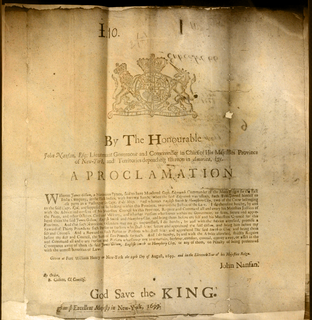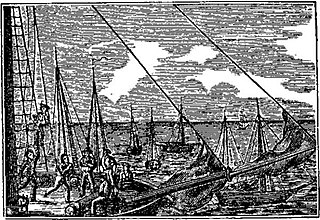Related Research Articles

William Kidd, also known as Captain William Kidd or simply Captain Kidd, was a Scottish sea captain who was commissioned as a privateer and had experience as a pirate. He was tried and executed in London in 1701 for murder and piracy.
Robert Culliford was a pirate from Cornwall who is best remembered for repeatedly checking the designs of Captain William Kidd.
Jeremiah Cocklyn, better known by the name Thomas Cocklyn, was an English pirate known primarily for his association with Howell Davis, Olivier Levasseur, Richard Taylor, and William Moody.
Adam Baldridge was an English pirate and one of the early founders of the pirate settlements in Madagascar.

James Gilliam, or James Kelly was an English pirate and buccaneer active off the coasts of Spanish South and Central America and later in the Indian Ocean. He sailed under several different pirate captains but is best remembered for his brief association with William Kidd.

Joseph Bradish (1672–1700) was a pirate best known for a single incident involving a mutiny.
Quedagh Merchant, also known as the Cara Merchant and the Adventure Prize, was an Indian merchant vessel famously captured by Scottish privateer William Kidd on 30 January 1698.
Jan Willems, also known as Janke or Yankey Willems, was a 17th-century Dutch buccaneer. Based out of Petit-Goâve, Willems participated in a number of expeditions against the Spanish during the early to mid-1680s with other well-known privateers including Michiel Andrieszoon, Thomas Paine, Laurens de Graaf, Nicholas van Hoorn and Michel de Grammont.
Ayas Nautical research club was founded in 1985. The range of its activities is quite wide, including historical aspects of World and Armenian navigation and shipbuilding, reconstruction of ancient Armenian vessels, study of sea routes, old maps, navigation devices, banners, collecting data on Armenian navigators, making underwater archaeological surveys and research. Since 1985 the Club has organized 15 exhibitions and has carried out several surveys on Armenian navigation. 26 different types of vessels used in historical Armenia, were restored and reconstructed. Members of the Club permanently participate in international conferences on underwater archaeology and nautical history and have published a number of articles.
Captain Kidd's cannon is an iron cannon that was discovered in 2007 off of the coast of Catalina Island in the Dominican Republic. The cannon is believed to be part of the wreckage of the Quedagh Merchant, a ship that was commandeered and later abandoned by Captain Kidd in 1699. It is the first pirate cannon that has been recovered from the Caribbean. One of 26 cannons found off the coast of Catalina Island, it was first taken to Indiana University's School of Health, Physical Education, and Recreation for investigation and research before being displayed in the exhibit National Geographic: Treasures of the Earth at The Children's Museum of Indianapolis in Indianapolis, Indiana.
John Cole was a pirate active off the American eastern seaboard. His brief career is associated with Richard Worley and William Moody. He is known more for the unusual cargo of his pirate ship than for his piracy.
Lewis Ferdinando was a pirate active near Bermuda during the Golden Age of Piracy.
Tempest Rogers was a pirate trader active in the Caribbean and off Madagascar. He is best known for his association with William Kidd.
Christopher Goffe was a pirate and privateer active in the Red Sea and the Caribbean. He was eventually trusted to hunt down his former comrades.
Thomas Woolerly was a pirate and privateer active in the Caribbean and the Indian Ocean.
George Peterson was a pirate active off New England and Nova Scotia and in the West Indies.
Don Benito was a Spanish pirate and guarda costa privateer active in the Caribbean.

William Lewis was a pirate supposedly active in the Caribbean, off the American east coast, and off the west coast of Africa in the 18th century. He was known for sparing his victims and for being killed after announcing he had made a pact with the Devil. He is likely the fictional creation of "Captain Charles Johnson" who presented his story among those of real historical pirates.
James Browne was a Scottish pirate and privateer active in the Caribbean. He is best known for his hasty execution and its effect on colonial Jamaican government.
Jean Tristan was a French corsair (buccaneer) and pirate active in the Caribbean and against Spanish holdings in Central and South America.
References
- ↑ Marley, David F. (2012). Daily Life of Pirates. Santa Barbara CA: ABC-CLIO. p. 175. ISBN 9780313395642 . Retrieved 11 July 2017.
- ↑ Gosse, Philip (1924). The Pirates' Who's Who by Philip Gosse. New York: Burt Franklin. p. 72. Retrieved 23 June 2017.
- 1 2 3 4 5 Office, Great Britain Public Record; Fortescue, Sir John William (1908). Calendar of State Papers: Colonial series ... London: Longman. pp. 459, 489–493, 554. Retrieved 11 July 2017.
- 1 2 3 4 Westergaard, Waldemar (1917). The Danish West Indies Under Company Rule (1671-1754): With a Supplementary Chapter, 1755-1917. New York: Macmillan. pp. 115–118. Retrieved 11 July 2017.
- 1 2 Zacks, Richard (2003). The Pirate Hunter: The True Story of Captain Kidd. New York: Hachette Books. ISBN 9781401398187 . Retrieved 11 July 2017.
